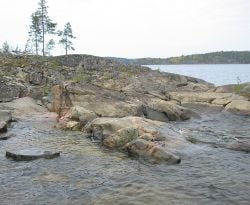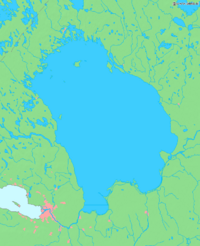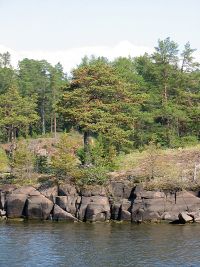Lake Ladoga
| Lake Ladoga | |
|---|---|
| Location | Northwestern Russia |
| Coordinates | |
| Primary sources | Svir, Volkhov, Vuoksi |
| Primary outflows | Neva |
| Catchment area | 276,000 km² |
| Basin countries | Russia, Finland |
| Max length | 219 km |
| Max width | 138 km |
| Surface area | 17,700 km² |
| Average depth | 51 m |
| Max depth | 230 m |
| Water volume | 837 km³ |
| Surface elevation | 5 m |
| Islands | about 660 (including Valaam) |
| Settlements | see list |
Lake Ladoga, located in the northwestern part of Russia, is the largest lake in all of Europe. The span of the lake is so large that it lies within the borders of two political provinces: the Republic of Karelai and Leningrad Oblast. In total, Lake Ladoga covers an area of 6,700 fresh water square miles, excluding islands. The width of the lake averages 51 miles, while the length is approximately 136 miles. Along with its impressive size, the lake is also remarkably deep, measuring 167 feet on average. The deepest point of the lake is found just to the west of Valaam Island where the lake dips to 754 feet.
Geography
The lake's area is 17,891 km² (excluding the islands). Its length (north to south) is 219 km, average width is 83 km, average depth is 51 m, maximum depth is about 230 m (in north-western part). Basin area: 276,000 km², volume: 837 km³[1] (earlier estimated as 908 km³);. There are about 660 islands, with a total area of 435 km². Ladoga's level above the sea is 5 m on average.[2] Most of the islands, including the famous Valaam archipelago, Kilpola and Konevets, are situated in the north-western part.
Separated from the Baltic Sea by the Karelian Isthmus, it drains into the Gulf of Finland via the Neva River.
The basin of the Ladoga includes about 50,000 lakes and 3,500 rivers longer than 10 km. About 85% of the water income is due to tributaries, 13% is due to precipitation, and 2% is due to underground waters. The most significant tributaries are:
- Svir River from Lake Onega (south-east, discharge: 790 m³/s);
- Volkhov River from Lake Ilmen (south, discharge: 580 m³/s);
- Vuoksi River from Lake Saimaa in Finland (west, discharge: 540 m³/s).
- Syas River (south, discharge: 53 m³/s).
The Ladoga is navigable, being a part of Volga-Baltic Waterway connecting the Baltic Sea with the Volga River. The Ladoga Canal bypasses the lake in the southern part, connecting the Neva to the Svir.
Deglaciation following the Weichsel glaciation took place in the Lake Ladoga basin between 12,500 and 11,500 radiocarbon years BP. Lake Ladoga was initially part of the Baltic Ice Lake (70-80 m. above present sea-level), a historical freshwater stage of Baltic Sea. It is possible, though not certain, that Ladoga was isolated from it during regression of the subsequent Yoldia Sea brackish stage (10,200-9,500 BP). The isolation threshold should be at Heinjoki to the east of Vyborg, where the Baltic Sea and Ladoga were connected by a strait or a river outlet at least until the formation of the River Neva, and possibly even much later, until 12th century AD or so.[3][4]
At 9,500 BP, Lake Onega, previously draining into the White Sea, started emptying into Ladoga via the River Svir. Between 9,500 and 9,100 BP, during the transgression of Ancylus Lake, the next freshwater stage of the Baltic, Ladoga certainly became part of it, even if they hadn't been connected immediately before. During the Ancylus Lake subsequent regression, around 8,800 BP Ladoga became isolated.
Ladoga slowly transgressed in its southern part due to uplift of the Baltic Shield in the north. It was hypothesized, but not proven, that waters of the Litorina Sea, the next brackish-water stage of the Baltic, occasionally invaded Ladoga between 7,000 and 5,000 BP. Around 5,000 BP the waters of the Saimaa Lake penetrated Salpausselkä and formed a new outlet, River Vuoksi, entering Lake Ladoga in the northwestern corner and raising its level by 1-2 m.[5]
The River Neva originated when the Ladoga waters at last broke through the threshold at Porogi into the lower portions of Izhora River, then a tributary of the Gulf of Finland, between 4,000 and 2,000 BP. According to some new data, it happened at 3,100 radiocarbon years BP (3,410-3,250 calendar years BP).[6]
Wildlife
The Ladoga is rich with fish. 48 forms (species and infraspecific taxa) of fish have been encountered in the lake, including roach, carp bream, zander, European perch, ruffe, endemic variety of smelt, two varieties of Coregonus albula (vendace), eight varieties of Coregonus lavaretus, a number of other Salmonidae as well as, albeit rarely, endangered Atlantic sturgeon. Commercial fishing was once a major industry but has been hurt by overfishing. After the war, between 1945–1954, the total annual catch increased and reached a maximum of 4,900 tonnes. However, unbalanced fishery led to the drastic decrease of catch in 1955–1963, sometimes to 1,600 tonnes per year. Trawling has been forbidden in Lake Ladoga since 1956 and some other restrictions were imposed. The situation gradually recovered, and in 1971-1990 the catch ranged between 4,900 and 6,900 tonnes per year, about the same level as the total catch in 1938.[7] Fish farms and recreational fishing are developing. [1]
It has its own endemic Ringed Seal subspecies known as the Ladoga Seal.
Since the beginning of the 1960s Ladoga has become considerably eutrophicated.[8]
Nizhnesvirsky Natural Reserve is situated along the shore of Lake Ladoga immediately to the north of the mouth of the River Svir.
History
In the Middle Ages, the lake formed a vital part of the Trade Route from the Varangians to the Greeks, with the Norse emporium at Staraya Ladoga defending the mouth of the Volkhov since the 8th century. In the course of the Swedish-Novgorodian Wars, the area was disputed between the Novgorod Republic and Sweden. In the early 14th century, the fortresses of Korela (Kexholm) and Oreshek (Nöteborg) were established along the banks of the lake.
The ancient Valaam Monastery was founded on the island of Valaam, the largest in Lake Ladoga, abandoned between 1611–1715, magnificently restored in the 18th century, and evacuated to Finland during the Winter War in 1940. In 1989 the monastic activities in the Valaam were resumed. Other historic cloisters in the vicinity are the Konevets Monastery, which sits on the Konevets island, and the Alexander-Svirsky Monastery, which preserves fine samples of medieval Muscovite architecture.
During the Ingrian War, a fraction of the Ladoga coast was occupied by Sweden. In 1617, by the Treaty of Stolbovo, the northern and western coast was ceded by Russia to Sweden. In 1721, after the Great Northern War, it was restituted to Russia by the Treaty of Nystad. Later, in 1812–1940 the lake was shared between Finland and Russia. According to the conditions of the 1920 Tartu Peace Treaty militarization of the lake was severely restricted. However, both Soviet Russia and Finland had flotillas in Ladoga. After the Winter War (1939-1940) according to the Moscow Peace Treaty, Ladoga, previously shared with Finland, became an internal basin of the Soviet Union.
During the Continuation War (1941-1944) not only Finnish and Soviet, but also German and Italian (see Regia_Marina#Lake_Ladoga) vessels operated there. Under these circumstances, during much of the Siege of Leningrad (1941–1944), Lake Ladoga provided the only access to the besieged city. Supplies were transported into Leningrad with trucks on winter roads over the ice, the "Road of Life", and by boat in the summer. After the World War II, Finland lost the Karelia region to the USSR, and all Finnish citizens were evacuated from the ceded territory. Ladoga became an internal Soviet basin again. The nortern shore, Ladoga Karelia with the town of Sortavala, is now part of the Republic of Karelia. The western shore, Karelian Isthmus, became part of Leningrad Oblast.
Notes
- ↑ Sorokin, Aleksander I. et al. (1996). New morphometrical data of Lake Ladoga. Hydrobiologia 322.1-3, 65-67.
- ↑ Калесник С.В. Ладожское озеро. Л.: Гидрометеоиздат, 1968.
- ↑ Ailio, Julius (1915). Die geographische Entwicklung des Ladogasees in postglazialer Zeit. Bull. Comm. Géol. Finlande 45, 1–159.
- ↑ Davydova, Natalia N. et al. (1996). Late- and postglacial history of lakes of the Karelian Isthmus. Hydrobiologia 322.1-3, 199-204.
- ↑ Saarnisto, Matti (1970). The Late Weichselian and Flandrian history of the Saimaa Lake complex. Societas Scientiarium Fennicae. Commentationes Physico-Mathematicae 37.
- ↑ Saarnisto, Matti & Tuulikki Grönlund (1996). Shoreline displacement of Lake Ladoga - new data from Kilpolansaari. Hydrobiologia 322.1-3, 205-215.
- ↑ Kudersky, Leonid K. et al. (1996). Fishery of Lake Ladoga — past, present and future. Hydrobiologia 322.1-3, 57-64.
- ↑ Holopainen, Anna-Liisa et al. (1996) The trophic state of Lake Ladoga as indicated by late summer phytoplankton. Hydrobiologia 322.1-3, 9-16.
ReferencesISBN links support NWE through referral fees
- Butler, Sue. 1998. Via Leeds to Lake Ladoga. Bradford: Redbeck Press. ISBN 9780946980642
- Viljanen, Markku. 2004. Sustainable use, management and monitoring of fish resources in Lake Ladoga. Karjalan tutkimuslaitoksen raportteja, n:o 4/2004. [Joensuu]: Joensuun yliopisto. ISBN 9789524585019
External links
- Simola, Heikki et al. (eds), Proceeding of The First International Lake Ladoga Symposium. Special issue of Hydrobiologia. Vol. 322, Issues 1-3. / April 1996.
- The Ladoga Lake (photos)
- War on Lake Ladoga, 1941-1944
- Maps
Credits
New World Encyclopedia writers and editors rewrote and completed the Wikipedia article in accordance with New World Encyclopedia standards. This article abides by terms of the Creative Commons CC-by-sa 3.0 License (CC-by-sa), which may be used and disseminated with proper attribution. Credit is due under the terms of this license that can reference both the New World Encyclopedia contributors and the selfless volunteer contributors of the Wikimedia Foundation. To cite this article click here for a list of acceptable citing formats.The history of earlier contributions by wikipedians is accessible to researchers here:
The history of this article since it was imported to New World Encyclopedia:
Note: Some restrictions may apply to use of individual images which are separately licensed.




